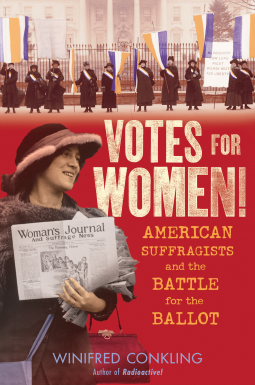
Acknowledging that many people know how the story ends with American women who have had the right to vote for nearly a hundred years and how it began in a women’s rights meeting in Seneca Falls, NY in 1848, Winifred Conkling sets out to fill out the in-between. Her book, Votes for Women, came out on February 2.
In a book that is much more entertaining than either its title or its subject matter would suggest, Winifred paints complicated portraits of the women who led the way in seeking equal rights. Though she focuses on the right to vote, much more is at stake in the world where Elizabeth Cady Stanton and Susan B. Anthony begin, where women can’t own property, where children automatically belong to the father in the event of a divorce, where any wages they earn belong to their husbands or fathers, where they can’t enter into contracts or sign legal documents. They couldn’t serve on juries or testify in court, and their husbands or fathers could legally beat them if they used a whip no thicker than a thumb.
Besides these names that we recognize from history, there’s Victoria Clafin Woodhull whose life story had more twists and turns than a mountain road. She ran for President forty years before women could vote on a platform of an eight-hour workday, graduated income tax, and reformed divorce laws.
After this first wave of activists, came a second wave. The two-part history has smart women finding loopholes and clever interpretations of the law and adding other social justice issues, such as temperance and abolition, to their agenda. Not qualifying any of these women for angel wings, Winifred reveals their abundant warts and their dissention among themselves. Hardships and terrifying episodes precede the ratification that finally occurred in 1920.
The fact that the book is published by Algonquin Books for Young Readers shouldn’t influence your decision to read it. If your heart is young, or even if it isn’t, as long as you love a well-told true story, get to a bookstore or talk your local librarian into ordering one since they really need it on the checkout shelf. The book could be described as timely history.